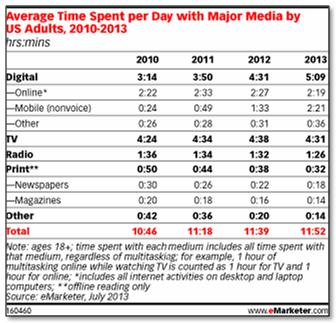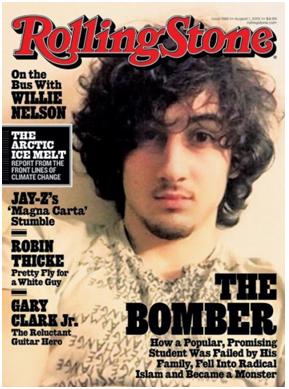Get ready for it because the headline in AdAge blares:
U.S. Adults Now Spending More Time On Digital Devices Than Watching TV
And deeper into the article, “Overall, the amount of time spent consuming media in all its forms – digital, TV, radio, and print – is cranking ever upward, though radio and print are dropping off, according to eMarketer.”
The big winner is mobile devices. Time spent using smartphones and tablets has now surpassed PCs. And mobile continues to grow and very fast. What isn’t said is that broadcast radio is doing a much better job proactively getting its content into mobile devices via applications like iHeartRadio, TuneIn, and individually branded apps like our company jacAPPS develops. As more media consumption migrates to mobile, radio is in a strong position to ride that wave.
But for print, the outlook isn’t nearly as good. And magazines look especially bad as only 14 minutes a day are spent with publications like Cosmo, Sports Illustrated, and Mad.
So when the news broke last week that Rolling Stone hit it out of the park with its controversial cover issue featuring Boston Marathon bombing suspect Dzhokhar Rsarnaev, perhaps your first reaction was to be impressed with this accomplishment.
In fact, the media stories trumpet the fact that Rolling Stone newsstand sales doubled!
Impressive, right? Until you learn they sold 13,000 magazines at retailers across the country. And that’s twice their normal volume.
Now I realize they do lots of subscription and digital archive sales. But 13,000 retail sales? Throughout America?
Isn’t that about the cume of an average station in Dubuque, Iowa? At night?
OK, I’m talking apples and grapefruits here, and newsstand sales doesn’t equate to someone turning on a Country or Rock station for five minutes once a week.
But the scope of these numbers and their reach is rather sobering.
And it makes me happy to be in radio where the ink never gets all over your hands.
- What To Do If Your Radio Station Goes Through A Midlife Crisis - April 25, 2025
- A 2020 Lesson?It Could All Be Gone In A Flash - April 24, 2025
- How AI Can Give Radio Personalities More…PERSONALITY - April 23, 2025






I’m not sure I agree with your conclusion about radio “riding the wave” onto mobile devices. This study shows radio on a steady and perhaps accelerating trend of losing TSL. The only way to calculate how well radio is riding that wave is to add mobile TSL to the on air figures and see if that puts it even or ahead of 21010 in 2013. I seriously suspect that adding in all of the mobile TSL is less than a rounding error.
In fact, radio’s performance in mobile devices is probably a pretty good predictor of how it will do in the evolved connected car. Its probably not just about devices, its about the content available on devices – and while radio does need to be available where people are going for media, that’s necessary but nowhere near sufficient.
IMO, radio can go two ways – pick one or ideally pursue both tracks. First, it can leverage the personal and live advantage of real personalities and interaction between those personalities and listeners. Radio has been on a path of squandering that advantage while simultaneously referencing it to rebut studies like the one cited here. At some point that strategy will pass foolish and venture into fatuous. People are what makes radio different and rather than documenting how many programming people can be replaced with machines or eliminated, radio could be measuring how many personal touches it can provide.
Second, radio can leverage its still superior programming knowledge to beat the Pandoras of the world at their own game. If they really did that, radio could potentially have more control over that part of media consumption – everything from monitization to royalty rates. Despite some nice apps out there, Pandora still rules the roost for streaming music – trouncing all of radio’s streaming efforts put together by a huge margin.
True, Rolling Stone has long been irrelevant and to put that into perspective, they sold roughly 44 issues of the bomber magazine in Metro Rochester, NY. But measuring yourself against Rolling Stone is like measuring your hair loss against mine.
Kris Kristofferson said “everybody’s gotta have somebody to look down on” but radio won’t grow by looking for media that’s falling faster than it is – radio will thrive by targeting media that’s surpassed it and pulling ahead.
First of all, Bob, I don’t want to get into a battle with you about hair loss. That’s a lose-lose.
Regarding the mobile piece, it goes beyond how much TSL is being generated by radio brands on mobile apps. It’s alsoa matter of “being there” – being where consumers are, offering them the chance to hear radio content. And as we’ve discussed a lot this week, the personality piece may be most essential for radio.
A new study by Ipsos OTX and Ipsos Global @visor indicates that brands benefit from having apps. It helps to generate greater interest and engagement – something highly necessary in the media world in which we live.
No doubt that usage is where the conversation begins and ends, but it starts with how brands are positioned in the minds and hearts of consumers. And at least in the mobile space, radio has made strides.
Thanks, as always, for keeping the conversation going in our “comments” section. Appreciate it.
Fred,
One point: Newsstand sales typically make up only about 15% of copy sales in the US and that issue was pulled from a lot of major retailers. So, the numbers aren’t as small as they seem. You’s still talking about a few hundred thousand in paid circulation.
– Greg
Greg, thanks for the perspective – and I had forgotten the issue had been banned by some retailers. From a radio guy POV, it struck me as low for a national publication. Appreciate you taking the time to comment.